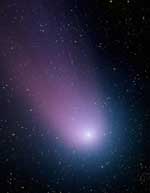
Image credit: NOAO/AURA/NSF
This image of Comet C/2001 Q4 (NEAT) was taken at the WIYN 0.9-meter telescope at Kitt Peak National Observatory near Tucson, AZ, on May 7, 2004.
The image was taken with the Mosaic I camera, which has a one-square degree field of view, or about five times the size of the Moon. Even with this large field, only the comet?s coma and the inner portion of its tail are visible. This color image was assembled by combining images taken through blue, green and red filters.
A small star cluster (C0736-105, or Melotte 72) is visible in the lower right of the image, between the head of the comet and the bright red star in the lower-right corner.
Comet C/2001 Q4 (NEAT) was discovered on August 24, 2001, by the Near Earth Asteroid Tracking (NEAT) system operated by NASA?s Jet Propulsion Laboratory, Pasadena, CA.
The comet will remain visible for several weeks with binoculars and small telescopes just after sunset, high in the western sky.
Image Credit: T. Rector (University of Alaska Anchorage), Z. Levay and L.Frattare (Space Telescope Science Institute) and WIYN/NOAO/AURA/NSF
Original Source: NOAO News Release
